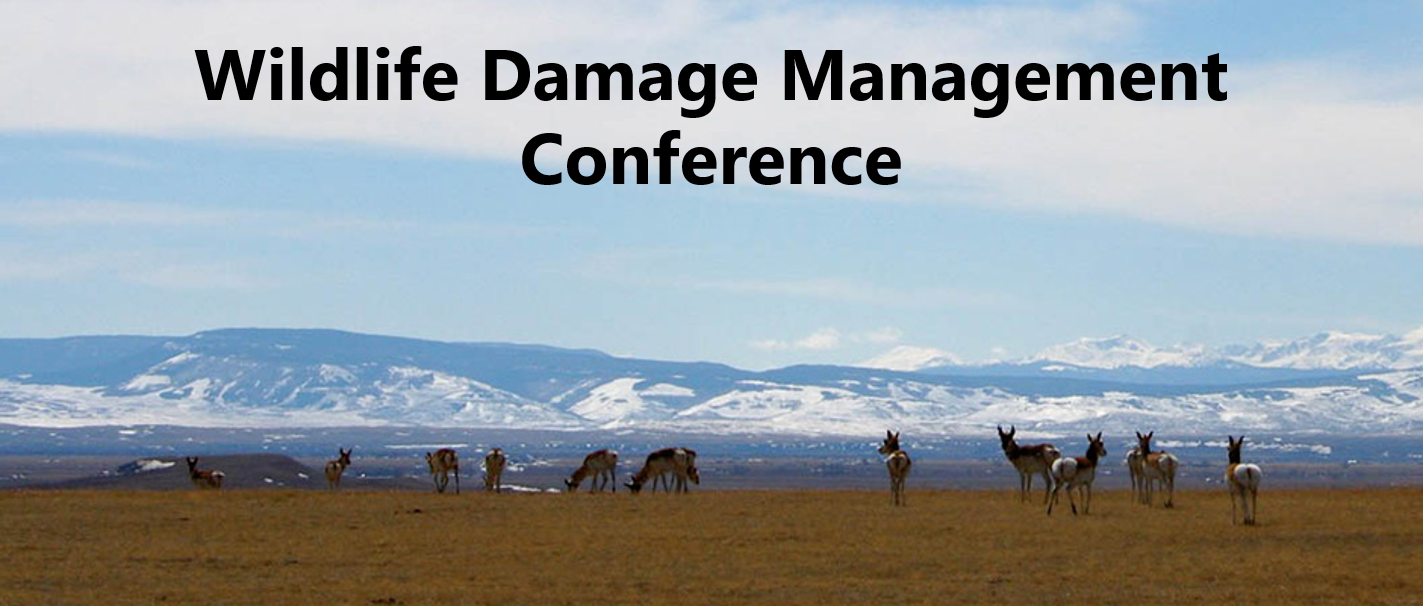Location
Orange Beach, AL
Start Date
27-2-2017 1:00 PM
Description
Lethal removal by trapping is one of the most cost- and time-effective means for managing wild pigs (Sus scrofa). Scent attractants are frequently used to lure wild pigs to camera stations for scouting or monitoring wild pig populations or at trap sites to reduce the amount of time for pigs to locate the trap. However, the effectiveness of scents to attract and increase wild pig visitation to camera stations or traps is debatable. Therefore, our objective was to determine if wild pigs visited camera stations sooner and more frequently when scents were used in addition to whole kernel corn. We conducted our study on portions of the state-owned Lowndes County Wildlife Management Area (5,650 ha) and on privately owned property (1,820 ha) in Lowndes and Macon counties, AL, respectively, during 2014-2016. We selected portions within these study areas where active, premeditated wild pig removal (trapping, shooting) had not occurred for at least 1 year in order to minimize biases associated with trap shy pig behavior. We sectioned each study area into 1km2 grids and assigned a camera station to each grid cell overlapping the study area. Within each grid cell, the camera station was subjectively placed in forest cover near water. We then assigned randomly treatments of corn (11.3 kg), corn and a molasses-based attractant (0.23 L), or corn and a pig urine attractant (15 ml) to each of 66 camera stations. Corn and attractants were replenished after 7 days. We then used motion-sensitive game cameras to record the time (in min) from the initial placement of bait and scent at each station until the first wild pig was captured on camera images. Cameras remained active on each station for 14 days and were set to capture 3-picture bursts with a 10-second delay among pictures and 1-minute delay between bursts. Camera stations were distributed within each study area at a density of approximately one station per 100-250 ha. We recorded the time of first detection, frequency of visits, and identifying characteristics of pigs and sounders. We used a Χ2 test to determine if frequency of visits differed among treatments and an ANOVA to determine differences in time until first visit differed among treatments. Wild pigs visited 23 of 66 (35%) bait stations which did not differ among treatment sites (P=0.231). Of these 23 active camera stations, time until first visit did not differ among treatments (P=0.599). Mean time until first visit to a station was approximately 62.0 hours (about 2.6 days). Scent attractants did not have a noticeable effect on increasing wild pig visitation to baited camera stations suggesting managers 28 should focus on proper placement of bait stations or traps in areas frequented by wild pigs rather than relying on scents to lure pigs to desired locations.
Recommended Citation
Lambert, Shannon M.; Smith, Mark D.; Williams, Bryan K.; and Johnson, Dana K., "Evaluation of Scents Attractants for Baiting Wild Pigs" (2017). Wildlife Damage Management Conference. 1.
https://digitalcommons.usu.edu/wdmconference/2017/session2/1
Evaluation of Scents Attractants for Baiting Wild Pigs
Orange Beach, AL
Lethal removal by trapping is one of the most cost- and time-effective means for managing wild pigs (Sus scrofa). Scent attractants are frequently used to lure wild pigs to camera stations for scouting or monitoring wild pig populations or at trap sites to reduce the amount of time for pigs to locate the trap. However, the effectiveness of scents to attract and increase wild pig visitation to camera stations or traps is debatable. Therefore, our objective was to determine if wild pigs visited camera stations sooner and more frequently when scents were used in addition to whole kernel corn. We conducted our study on portions of the state-owned Lowndes County Wildlife Management Area (5,650 ha) and on privately owned property (1,820 ha) in Lowndes and Macon counties, AL, respectively, during 2014-2016. We selected portions within these study areas where active, premeditated wild pig removal (trapping, shooting) had not occurred for at least 1 year in order to minimize biases associated with trap shy pig behavior. We sectioned each study area into 1km2 grids and assigned a camera station to each grid cell overlapping the study area. Within each grid cell, the camera station was subjectively placed in forest cover near water. We then assigned randomly treatments of corn (11.3 kg), corn and a molasses-based attractant (0.23 L), or corn and a pig urine attractant (15 ml) to each of 66 camera stations. Corn and attractants were replenished after 7 days. We then used motion-sensitive game cameras to record the time (in min) from the initial placement of bait and scent at each station until the first wild pig was captured on camera images. Cameras remained active on each station for 14 days and were set to capture 3-picture bursts with a 10-second delay among pictures and 1-minute delay between bursts. Camera stations were distributed within each study area at a density of approximately one station per 100-250 ha. We recorded the time of first detection, frequency of visits, and identifying characteristics of pigs and sounders. We used a Χ2 test to determine if frequency of visits differed among treatments and an ANOVA to determine differences in time until first visit differed among treatments. Wild pigs visited 23 of 66 (35%) bait stations which did not differ among treatment sites (P=0.231). Of these 23 active camera stations, time until first visit did not differ among treatments (P=0.599). Mean time until first visit to a station was approximately 62.0 hours (about 2.6 days). Scent attractants did not have a noticeable effect on increasing wild pig visitation to baited camera stations suggesting managers 28 should focus on proper placement of bait stations or traps in areas frequented by wild pigs rather than relying on scents to lure pigs to desired locations.


